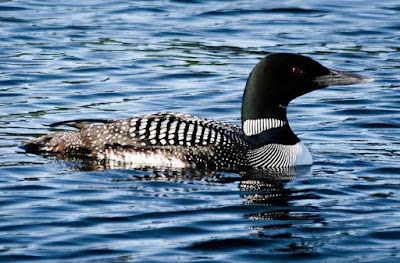Water Strider. Jack Pot.
The day was sunny and bright and to find our destination, the lake, we had to drive down a long, dirt road to get there. Perhaps one could get lost? The aesthetics were pleasing, and different types of vegetation surrounded the lake. We armed up with our lifejackets and jumped into our canoes. We paddled around the banks of the lake to look for any insects flying about or perhaps hopping around in the water. Lilypads were gravitating towards the side of the lake and close to the banks, and there was a loon in her nest. A particular insect caught my sight as it was jumping around in the water by the bank. I quickly grabbed the insect with my net, and the first thing I noticed was its long legs; I guessed that it was a Water Strider. I thought "jackpot," because I knew it was from the order Hemiptera, and I lacked families in that order for my collection. From then on, Eden and I were meticulously looking for insects in or on the water, but the only insects we kept seeing were the Water Striders! So, I decided to research more about Water Striders, as well as link together some information I have been learning in class.
 |
| https://www.adirondack.net/wildlife/loons/#1 |
Water Striders are from the Order Hemiptera and the family Gerridae. Water Strider’s also have other names such as pond skaters or Jesus bugs because of their ability to walk on water by the use of surface tension (BugGuide). Since the surface of water tends to have different molecular interactions, it creates a membrane that the Water Striders can walk on (National Wildlife Federation). Because of this, Water Strider’s are known to live in marine or freshwater habitats like lakes, ponds, marshes or slow streams and rivers. Water Striders have distinctive water-repellent hairs on the back and middle part of their legs to help them walk on water and to keep them dry (Missouri Department of Conservation). If at any point the tarsi become wet, the insect can no longer stay on the insect film, and it will drown unless it can crawl to a dry surface (Triplehorn et al., 2006). The Water Strider’s legs are the main point of identification for the insect. Their three pairs of legs have distinct hind femurs, which are longer than the abdomen and this gives them the ability to distribute their body weight to walk on water. Water striders do have wings, but they only use them to fly from habitat to habitat (Lytle, 2015). Wing polymorphism can also occur throughout the generations of Water Strider’s in response to the environment, in which at different times some generations have wings and some are apterous. Thus, wing functionality is correlated with their habitat. Water Striders are considered to be predators of aquatic and terrestrial insects such as spiders or mosquito larvae. They also, of course, have predators themselves such as fish and other aquatic insects (Triplehorn et al., 2006).
 |
| https://www.flickr.com/photos/kaidohmaru/2225172850/ |
Water Striders undergo incomplete metamorphosis and lay their eggs on rocks or surrounding vegetation near the water during the spring. The egg stage develops into the nymph stage, which undergoes around five instars until it reaches adult. The amount of eggs a female lays is in direct proportion to food resources (if there is less, they will lay fewer eggs). Something interesting about Water Striders, or insects in general, is the fact that sexual reproduction increases the vulnerability to predation. Because of this risk, male activity is low for copulation (Lytle, 2015). Other variabilities include the small selection females have for reproducing, in which they typically go for larger males to breed with (Fairbairn, 2017). Water Striders also have flexibility for life cycles. From any cohort*, they have the variability to develop and mature in the first year or wait to fully develop in their second year (Water Striders and Pond Skaters).
Reference List
“Family Gerridae - Water Striders.” Stick Bug - Anisomorpha buprestoides - BugGuide.Net, Iowa State University, bugguide.net/node/view/163#food.
“Water Striders | National Wildlife Federation.” The National Wildlife Federation, The National Wildlife Federation, www.nwf.org/Educational-Resources/Wildlife-Guide/Invertebrates/Water-Striders.
“Water Striders.” MDC Discover Nature, Missouri Department of Conservation, nature.mdc.mo.gov/discover-nature/field-guide/water-striders.
Triplehorn, Charles A., et al. Borror and DeLong's Introduction to the Study of Insects. Thompson Brooks/Cole, 2006.
Lytle, David A. “Gerridae.” Egyptian Journal of Medical Human Genetics, Elsevier, 2015, www.sciencedirect.com/topics/agricultural-and-biological-sciences/gerridae.
Fairbairn, Daphne J., and Richard F. Preziosi. “SEXUAL SELECTION AND THE EVOLUTION OF SEXUAL SIZE DIMORPHISM IN THE WATER STRIDER, AQUARIUS REMIGIS.” Freshwater Biology, Wiley/Blackwell (10.1111), 31 May 2017, onlinelibrary.wiley.com/doi/epdf/10.1111/j.1558-5646.1996.tb03927.x.
“Water Striders and Pond Skaters.” The Anemones, Corals and Jellyfish (Phylum Cnidaria), www.earthlife.net/insects/gerromorpha.html.


Comments
Post a Comment